Cambodia Hop Along - Siem Reap
- Cristina Dwyer

- Mar 12
- 14 min read
Updated: Jul 10
Why a “Hop Along”? Well, for the same reason that Vietnam got to be a “Hop Along”. And, if you’re curious, you can get all the scoop in the Vietnam Hop Along - Hanoi and Ha Long Bay post.
Originally, Cambodia wasn’t even on our itinerary. Vietnam alone seemed like an impossible feat for a 10-day trip. But then, some well-travelled friends insisted that we had to make time for Cambodia. So, for a change, I listened. I chose an itinerary that compromised a bit on Vietnam and squeezed in a two-day stay in Siem Reap to wrap up our trip.
We caught an early morning flight from Ho Chi Minh City (Saigon) to Siem Reap, where our local guide, Mr. Chann, and our driver were waiting for us. A quick stop at the hotel to drop our luggage, and we were back on the road.
We kicked off our tour with a bang - Angkor Wat! A UNESCO World Heritage Site since 1992, the largest religious structure in the world (as per the Guinness Book of Records), and proudly featured on Cambodia’s national flag, Angkor Wat is more than just a temple, it’s a symbol of the nation.
We entered through the East Gate, approaching the temple from the back. As we walked closer, we paused to take in the view from a distance. I didn’t know much about its history at that time, but I could already feel its presence.
The temple commands attention from its very base – a multi level stone terrace that makes it rise above all surroundings, like a mountain. Its ogival-shaped towers, dark silhouettes reaching for the sun, looked like a charcoal sketch drawn on the cloud brushed blue sky. The façade, an intricate blend of galleries, doorways, and columns, radiated power and mystery. I was looking at it, without moving, and I felt as if an unseen force was luring me closer.
The guide’s voice snapped me out of my daydream, nudging us forward. As we walked, he started to unravel some of Angkor Wat’s long and complex history. The “Temple City”, as it would translate from Khmer, was built in the early 12th century by King Suryavarman II as a Hindu temple dedicated to Vishnu, and it originally stood at the heart of the Khmer Empire. By the end of the century, under a new king whose wife was a devout Buddhist, it was converted into a Buddhist temple, a designation it has maintained ever since.
Over the centuries, invaders, looters, and time itself have left their marks (the dark colouring of its walls is a side effect of acidic rain water). The temple has lived many lives - glorious and revered, forgotten, hidden behind the lush vegetation, rediscovered over and over, by worshipers or explorers; somehow it was never fully abandoned.
As we entered the temple and neared the meticulously carved bas-reliefs, I understood why I had felt that invisible pull. Its beauty was just beginning to reveal itself. Since most of the carvings date back to the temple’s original construction, Hindu motifs and symbolisms dominate the artwork. The precision and detail are extraordinary - intricate facial expressions, elaborate hairstyles, ornate jewelry and clothing, along with lifelike depictions of plants and animals. But what truly left me in awe was the sheer scale. I walked through galleries stretching tens of meters long and several meters high, covered in these meticulously carved scenes.
Buddhist sculptures were also scattered throughout. Many, however, were missing their heads, victims of looters who found them the easiest pieces to smuggle. Their presence was steady and peaceful, as if, even in their fragmented state, they remained guardians of this sacred place.
We ended our tour by exiting through the West Gate, the temple’s main entrance - a structure whose grandeur still stands as a powerful reminder of the once-mighty Khmer Empire.
Just as we were about to leave the complex, our guide had us pause and look back. And there it was, the iconic image of Angkor Wat - majestic, enigmatic, eternal.

It was well past lunchtime, and after some significant walking up and down in the 30°C+ heat (one of us showing more determination than ability), we were more than ready for a break.

We went to a nearby restaurant where I had my first-ever taste of traditional Khmer cuisine - Fish Amok. Served in a coconut instead of the traditional banana leaf, it instantly won me over and, from that moment on, I ordered it whenever I had the chance. The dish, seemed to be a blend between the Thai and Vietnamese cuisine - had the creamy texture of a thick soup, not too coconutty, lightly spiced with green curry and infused with aromatic herbs, including a personal favourite, lemongrass. Its flavours were well balanced and, with every spoonful, it was as if each ingredient was trying to impress my taste buds just a little more than the last.
Re-energized, we set off for our next objective - Ta Prohm ("Ancestor Brahma"). Though one of the largest Buddhist temples of the Khmer Empire and a UNESCO World Heritage Site, its real claim to global fame came not from history books but from Hollywood, specifically, Lara Croft: Tomb Raider. Featuring Angelina Jolie, the movie was partly filmed here, earning the temple its nickname, the “Tomb Raider Temple.”
The moment I arrived, I understood why filmmakers chose this place. With Angkor Wat, I was in awe in front of it regal stance. But Ta Prohm? I was puzzled at first. The site was visibly in ruins, yet it seemed so … wildly alive. Towering trees and thick roots intertwined with the ancient stone, as if they had long been in a quiet battle for dominance. “Which was here first, the temple or the trees?”, I asked our guide. “The temple”, he answered. Once again, I felt that irresistible pull, a silent invitation to step closer.
Built in the late 12th century, not long after Angkor Wat, Ta Prohm was once a thriving Buddhist temple. But, after the fall of the Khmer Empire in the 15th century, it was abandoned, left to time and neglect for centuries. And so, instead of people, the jungle moved in, embracing it like a devoted worshipper. Trees have grown through walls, over rooftops, around doorways, wherever they pleased. But rather than looking out of place, they seem like an intrinsic part of the temple. They haven’t just taken over, they enhanced its beauty, adding to its mystique. The temple felt like a sleeping ancient creature, breathing life through the trees while remaining firmly anchored in its past.
Stone reliefs still adorn the walls, their details softened by time; some are purely decorative, others depict Buddhist themes, meditative figures, and prayers. The temple was built as a place of faith and nature’s touch has only deepened that sense of quiet reverence.
As I turned for a final glance, the temple no longer felt wild. It felt serene, so effortlessly Buddhist.
The Angkor Archaeological Park spans 400 square kilometres and holds around 40 significant archaeological sites, far more than we could cover in our short visit. Luckily, our tour included one more - Banteay Kdei ("Citadel of Monks' cells").
Built in the late 12th to early 13th century, this Buddhist temple shares a similar architectural style with Ta Prohm, but on a smaller scale. Tucked into nature, it was more subdued, its weathered structures visibly bearing the weight of centuries. Many sections were in ruins, carvings faded, and parts of the site were cordoned off for restoration and safety.
Unlike the previous sites, I wasn't asking too many questions, I preferred to just ... wander in silence. I think our guide sensed that, as he only interrupted occasionally making sure we don’t miss out on important architecture and history facts. By then, I had long given up trying to memorize dates and kings’ names as it didn’t seem to matter that much. I just wanted to use the time I have left to take in what was around me - the proof of the great civilizations that would otherwise be forever forgotten, a window into a mysterious past.
The exit gate, shaped as an ogival arch, was topped with an impressive sculpture of four Buddha faces, each gazing in a different direction, as if keeping watch. From the distance, the doorway seemed small and bright, in high contrast with the shaded temple site. We were on our way back into the present.
As we drove away, I tried to focus on my surroundings, but my mind kept replaying snapshots of Angkor, its temples, its stories, its quiet power. I probably would have stayed lost in that world a little longer if I hadn’t been summoned out of the car. We had arrived at our day tour grand finale, the Mudita Spa. The moment we stepped inside and settled into the elegant, calming guest area with a cup of tea, sensed the soothing aromas, I knew that was exactly what I needed. We had a full-body massage with aromatic oils, both relaxing and revitalizing. Couldn't have planned it better myself!
We spent the evening exactly where everyone new in town goes after dark, the Pub Street and the Night Market!
Pub Street is a pedestrian-only zone buzzing with restaurants, pubs, massage parlours, and ... fish pedicure shops (tempting, but we passed). With New Year decorations adding extra sparkle, the place felt even glitzier and livelier. The Night Market was a bottomless treasure chest of local artisan goods, handcrafts, souvenirs and local snacks. It was a real delight to look around, made even better by the reserved vendors.
After a quick tour of the area, we decided to cross the river to check out the other side. To our surprise, we found food and drink stands, improvised mini terraces overlooking the water, and … many locals! Away from the touristic area, it was pleasantly quieter. We settled on a spot with a good view, watching the animated, colourfully lit life across the river while reflecting on the incredible day we just had. I had been in Cambodia for less than 24 hours, yet somehow, I felt quite comfortable.
Our second day promised to be just as packed as the first. In the morning, we set off on a countryside tour in an open safari Jeep, a first for me! As getting in and out through the door was tricky with my injury, I ended up muscling myself through the side opening and sliding on and off the back seat with surprising ease. I felt like a real explorer!
Our first stop was the War Museum Cambodia, dedicated to the memory of the Cambodian Civil War. Located just outside Siem Reap, the museum holds a collection of weaponry, uniforms, and war equipment like tanks and helicopters, of different origin (US, Soviet, Chinese). Most of it is displayed outdoors, scattered through a mango orchard. As I walked through, listening to our guide recounting the country’s painful past, I felt my heart sink - so much hardship, so much suffering. The contrast was stark - lush green trees gleaming in the morning sun, standing beside rusted, lifeless war machines, frozen in time. They lay silent now, a chilling lesson for our present, for our future.
We left the museum and drove along the highway for a half an hour or so, before turning onto some more jeep-worthy countryside roads. After passing through small villages and dormant rice fields, a few cows lazily feasting in the distance, our jeep pulled over, at … someone’s home.
In Cambodia, villagers live off the land, growing rice and vegetables, raising animals, or fishing. But since farming isn’t a year-round job, some take on side businesses to supplement their income. The family we visited had turned their home into a small business, preparing takeaway-style street food and making a Cambodian traditional snack called “kalan”, bamboo sticky rice, to be sold at markets and temples. We were shown how it is being prepared and eaten.
The bamboo is first cleaned and cut into short sticks, each no longer than the space between two nodes; one end is left open, the other is sealed by a natural bamboo node, like a built-in base. Inside, a mixture of sticky rice, coconut milk, black-eyed peas, grated coconut, and sugar is packed in tightly, then capped with a mop of coconut husk. The filled bamboo sticks are then slow roasted over a bamboo leaf fire for about 90 minutes.
The result is quite delicious. It was definitely filling (it reminded me of the glutinous rice cake from the Beijing trip) and had a distinct flavour that I really liked - moderately sweet and coconutty and lightly smoked.
There is a bit of a ritual to eating it. Once it cools down enough to be able to handle it with bare hands, you roll the stick between the hands to loosen it up a bit, peel the bamboo away, strip by strip, to “open” the stick. Then, using the fingers, just take some of the sticky rice filling, which holds together quite well. The bamboo stick turns out to be the perfect food wrapper as you can loosely put back the bamboo strips and take it for the road. No wonder it is everyone’s go-to snack.
I really enjoyed our time there. It was a multi-generational household, very welcoming. We sipped on fresh coconut water, chatting with the family with our guide’s help. The adults and older kids were busy in the outdoor kitchen, prepping food for their front-yard stand, while the younger ones, curious and shy, inched closer, pretending to go about their business, throwing from time to time a few sidelong glances. So adorable!
We bid farewell to our hosts and made our way to Wat Svay Romeat Pagoda, a Buddhist temple tucked away from the usual tourist route, on the south side of West Baray Lake. Nestled among lush greenery, the temple, painted in a warm yellow mustard colour and ornated with Buddhist motifs, radiated a quiet joy. From the distance I could hear the rhythmic chanting of monks, their voices carrying through the trees, blending with the murmurs of the worshippers deep in prayer.
We wandered down towards the lake, following a shaded pathway that hugged the water’s edge. Along the way, there were wooden planks inscribed with Buddhist aphorisms, a quiet invitation to pause and reflect. Once again, my slow pace worked in my favour, giving me time to read most of them.
A few food vendors had set up shop nearby, offering local specialties. Grilled bamboo fish seemed like a solid choice, but then our guide introduced us to something a bit more… adventurous - boiled eggs with chicks nearly ready to hatch inside. Yeah ... I know what you're thinking, I did too then.
But, the best was yet to come - our acquaintance with some of Cambodia’s shall we say “unconventional” food wasn’t going to resume just to eye contact. On our way back from the temple, our guide pulled over at a roadside food stand selling a fresh assortment of crickets, grasshoppers, some kind of worms and black bugs whose name escapes me. He encouraged us to give it a try. Eddie was good sports, I only braved the crickets, a safe-ish choice, though … I did have to look away. True story!
Well, with that culinary experience under my belt, I was wondering what else our truly awesome jeep tour guide was having in his goody bag for us. And, as if he had read my mind, he surprised us with yet another first-time experience - a rattan craft workshop.
The owner of this shop was a lady of distinct beauty – she had piercing light blue eyes, very rare for Cambodian people. A single mother, widowed, she was supporting her family with her craft. Her shop was stacked with baskets, lamps, fans, table mats, all sorts of houseware objects, both beautiful and practical. I learned that not only she was doing all the weaving by herself, but also she was sourcing and preparing the raw rattan, a very difficult job. The beautiful blue-eye lady was working continuously while talking to us and made it look quite easy. Only when she had us make a small coaster I realized how hard it was – you need to have strong hands, with a good grip of the tough fiber and be quite precise, as a mistake is hard to mend.
Our countryside tour was one of the highlights of our trip. There was something special about waving at strangers and being met with genuine smiles, spotting a motorbike carrying a giant kite (turns out there was a kite festival), and locking eyes with shy, curious kids whose big brown eyes could steal your heart in an instant. Simple moments, but unforgettable ones.
In the afternoon, we explored another unique slice of life near Siem Reap - Tonle Sap Lake, the largest freshwater lake in Southeast Asia and a UNESCO Biosphere Reserve known for its diverse ecosystem.
We reached the lake by boat, passing through Kampong Phluk, the largest village on the lake. Since it was late December, peak dry season, the low water levels gave us a rare insider’s view of the village’s architecture. Here, everything, be it houses, police station, church, or a temple, sits on towering stilts, designed to withstand the dramatic rise in water levels during the rainy season. The houses, though similar in design, varied in colour and size, often featuring small balconies adorned with flowers, personal artifacts, and a Buddhist shrine near the entrance. Fishing has sustained this community for generations and, judging by the boats, fishing nets, and platforms stacked with gear, it’s a way of life that won’t be changing anytime soon. A floating world, built to adapt, yet deeply rooted in tradition.
Once arrived at the lake, we traded the big traditional boat, albeit motor-powered, for a smaller paddling boat that would take us on a mangrove tour. Our paddler was a middle-aged lady, just like most of the paddlers that were stationed outside the dock, waiting for tourists.
We glided through narrow canals carved into the flooded forest of freshwater mangroves, a maze of tangled roots and dense greenery. Our paddler, seated cross-legged on the bow, steered effortlessly with a single paddle. Each time she turned to check on us, she did so with a gentle, caring smile.
The water was perfectly still, except near the open lake, where a few rippling waves hinted at its vastness and quiet power.
It was so silent that the only sounds were the paddle dipping into the water or softly knocking against sunken mangrove trunks. The sunlight was piercing through the canopy, casting soft shadows, and for a moment, the tranquility of it all felt almost meditative.
We returned to the mainland, following the same route, through Kampong Phluk village and headed out towards the city.
Our afternoon guide, Mr. Chann, had one last stop planned to wrap up the day - a silk workshop. What made this atelier special wasn’t just the handwoven silk, but the fact that all the dyeing was done with natural, plant-based colours.
A few women sat in front of the shop, weaving or prepping plants, while the fabric dyeing took place around the back. I stepped inside the store, just for a quick look, of course. No harm in browsing, right? "Again?" you might say. Well… it wasn’t as quick as I planned. The shop was filled with beautifully crafted outfits and scarves imprinted with natural leaves and flowers, each one truly unique. Resisting? Impossible. I walked out with a scarf, a little piece of Cambodia to wrap around my neck and carry out my beautiful memories.
In the evening, we went back to the Pub Street for a last stroll. We sat down for dinner on a terrace, observing the lively crowds perusing up and down the street. Our trip was coming to an end, and I felt a bit melancholic.
On our last morning, with a bit of time to spare before our flight, we decided to wander back to the old (night) market, just to kill some time. We took a different route, and somehow, we stumbled into a fresh produce market unlike any I had ever seen. It was the perfect farewell. The lively chatter of vendors and buyers, the explosion of colours, the sheer variety of produce, they all put a permanent smile on my face. I walked around wondering whether the baskets of the blue-eye lady would be there.
I love old style markets, the personal interactions, the energy. It’s something that modern supermarkets or online shopping will never replace, no matter how convenient they are.
Angkor Wat is Cambodia’s symbol, its most famous landmark. I chose it as my story’s headline photo for its recognizability, but, in my heart, Cambodia’s best ambassador is its people’s kindness.
I will forever carry with me the caring gaze of our mangrove boat paddler, the beaming smile of the rattan shop owner, the two laughing men balancing a giant kite on a motorcycle, the market vendor’s joy at an early morning sale, the warm welcome of the kalan-making family and, last but not least, the hospitability of our local guides who helped us truly experience the beauty of this country and its people.
So glad I’ve listened to our friends! If you ever have the chance to be in the region, try to make some time for Cambodia.




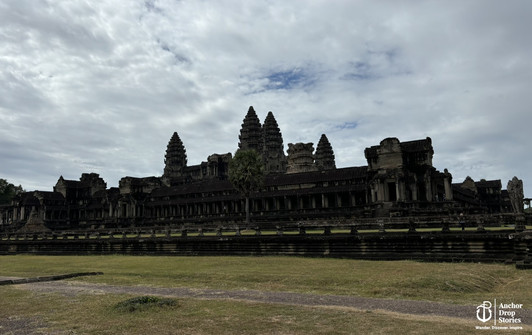
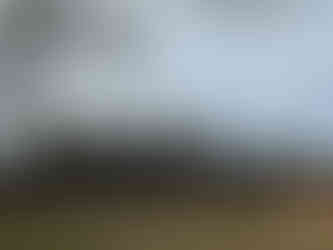


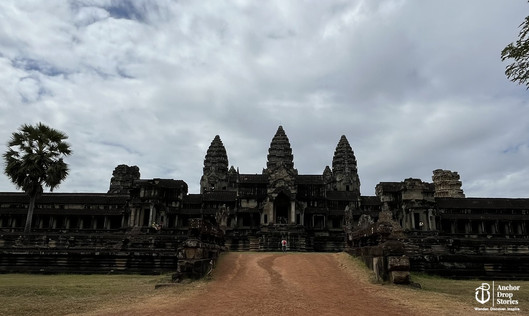









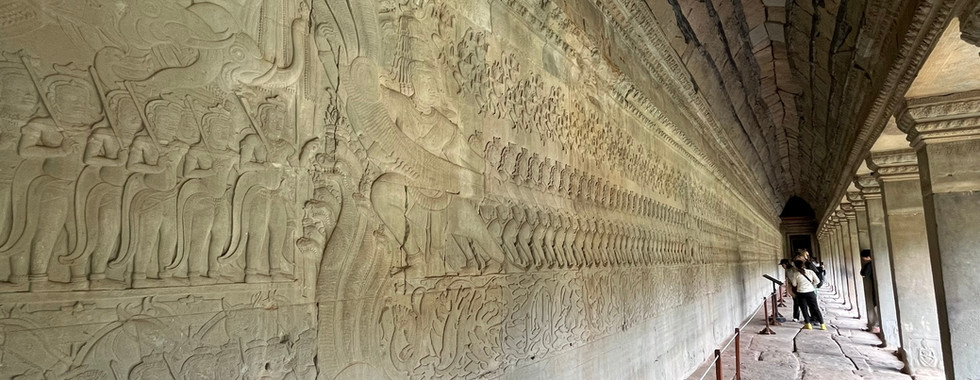



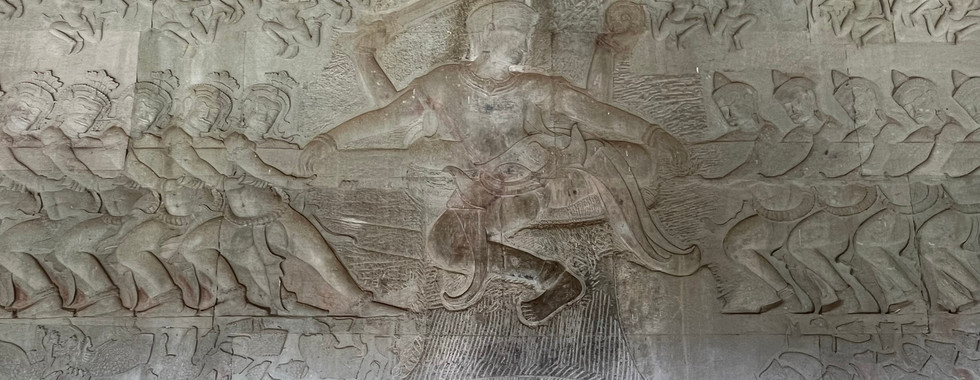







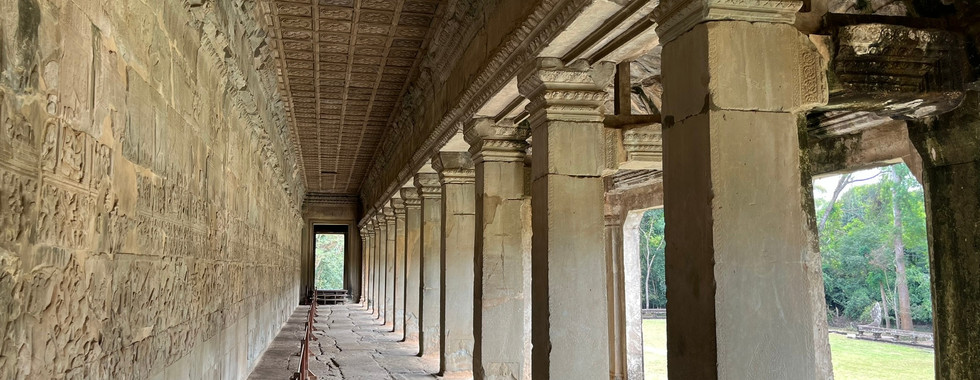








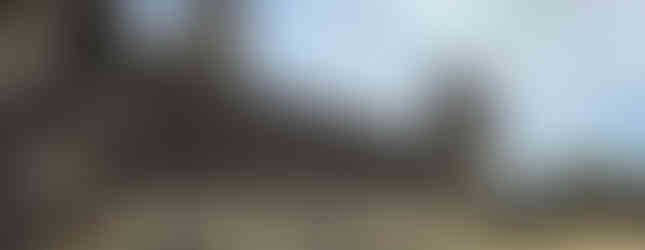














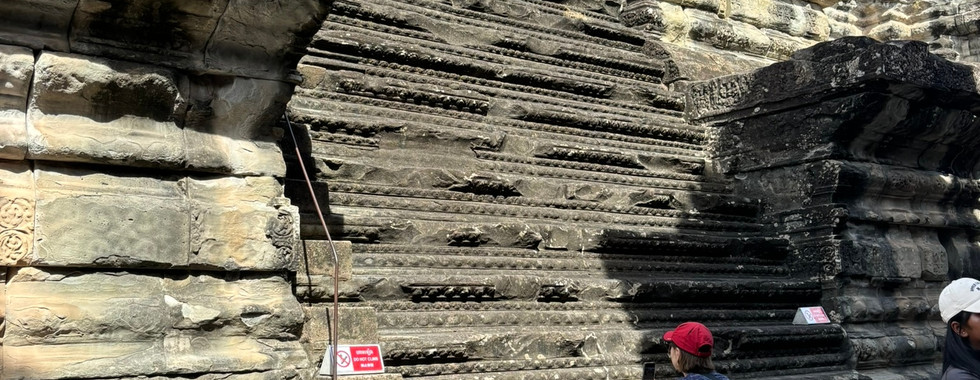



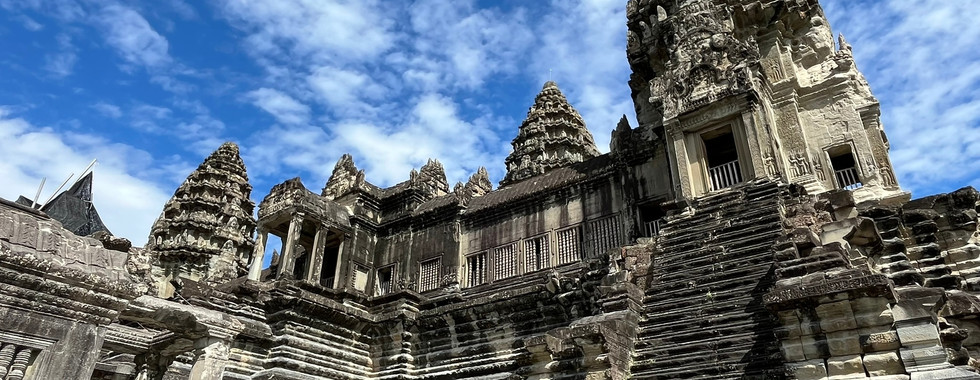











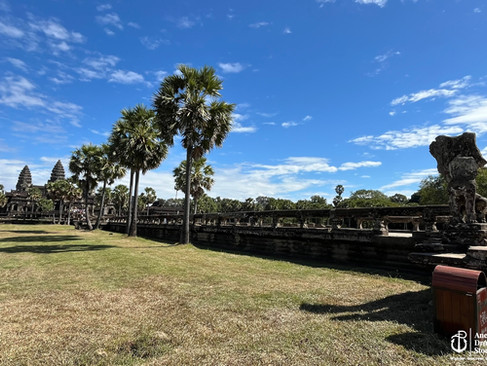







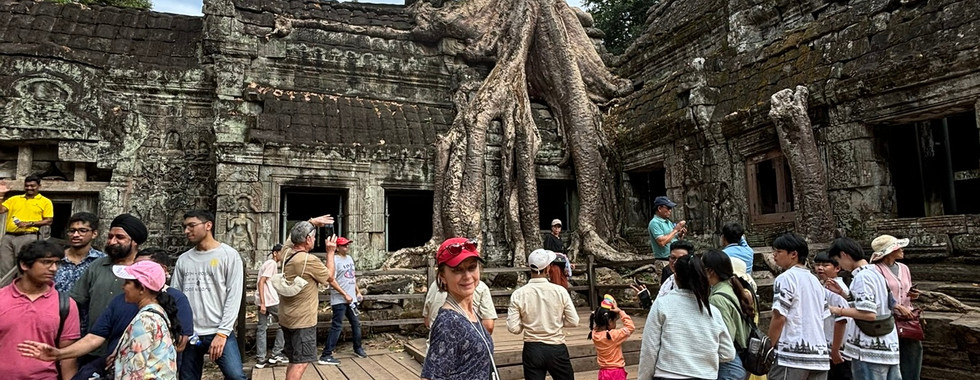







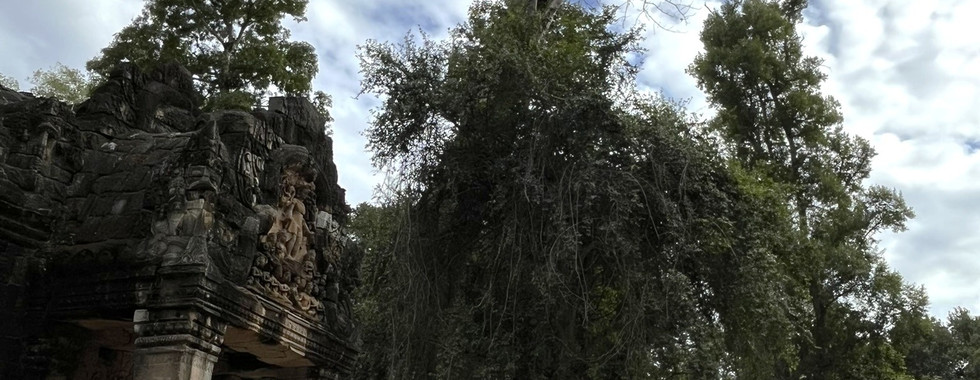





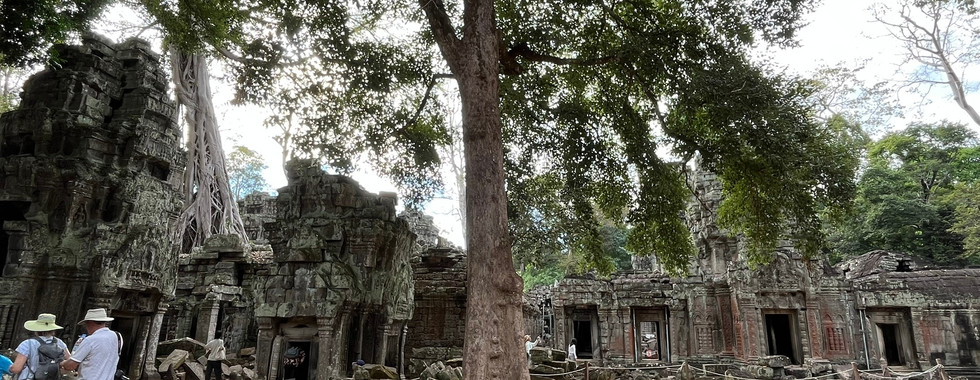

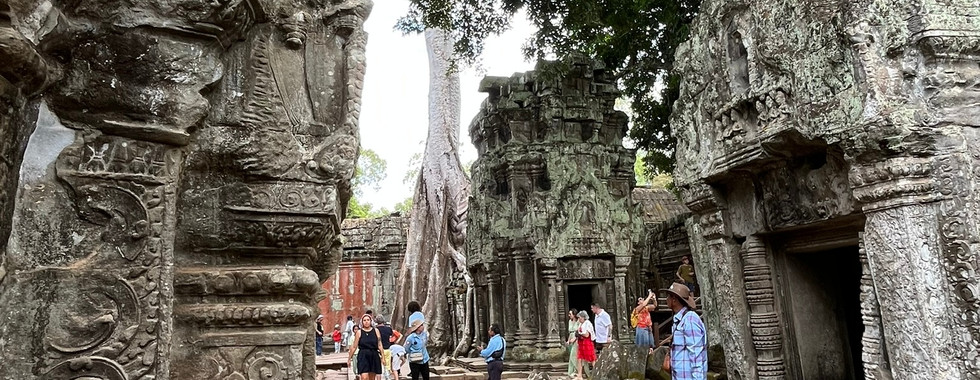















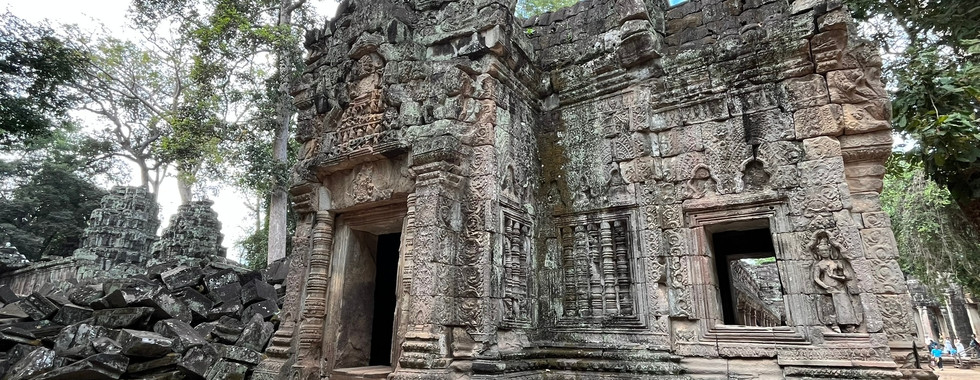



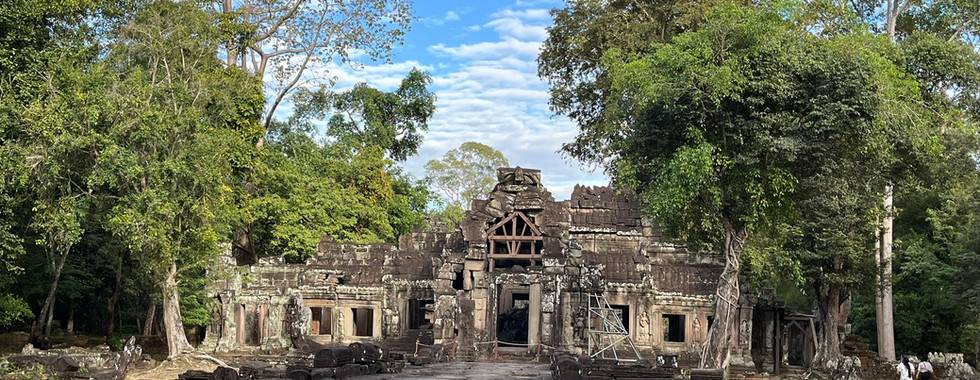

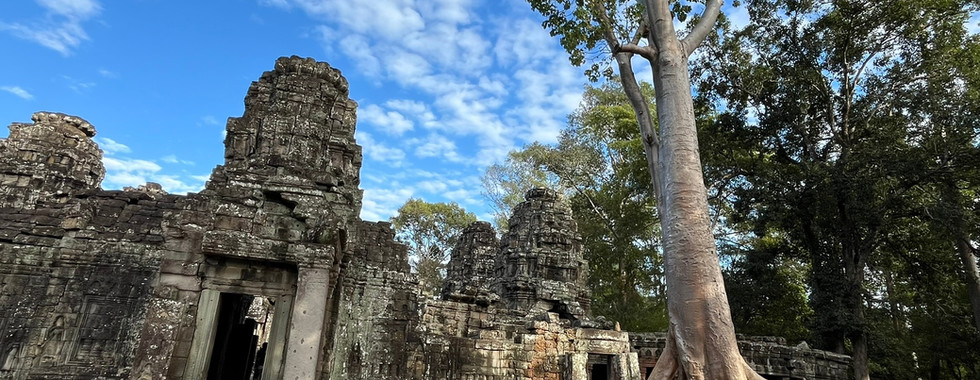











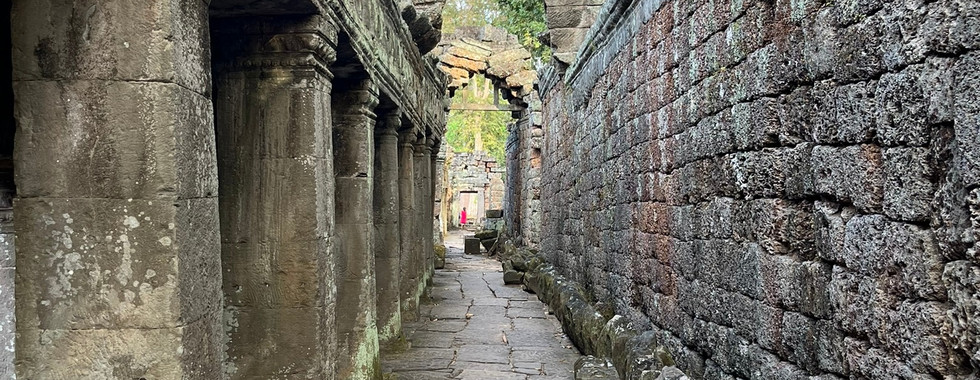





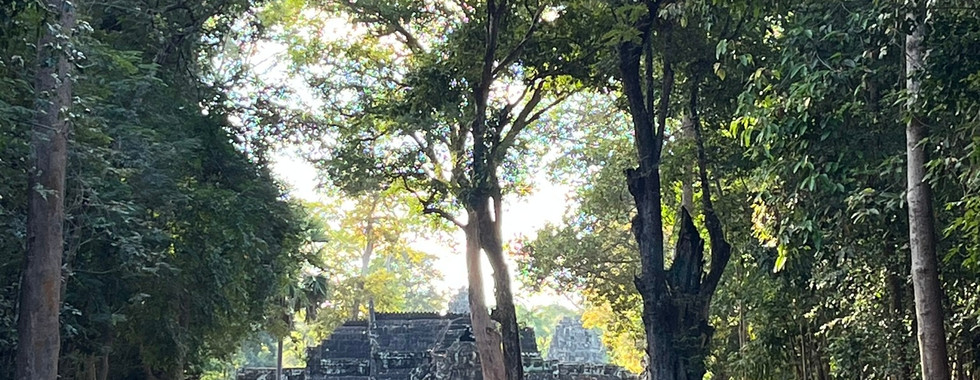











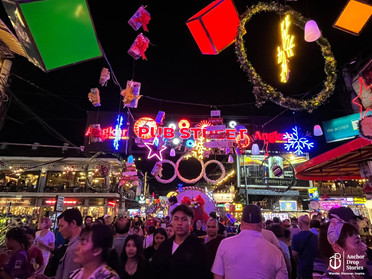







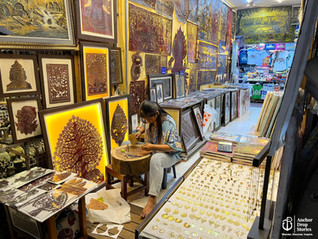













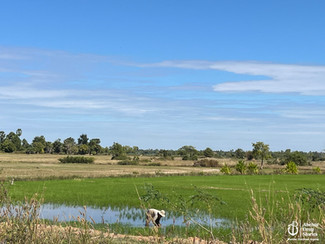







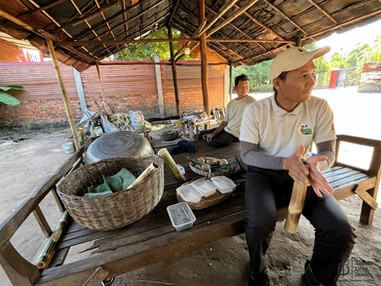

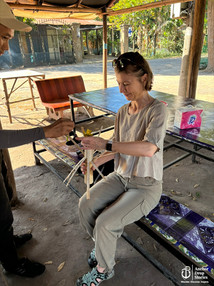



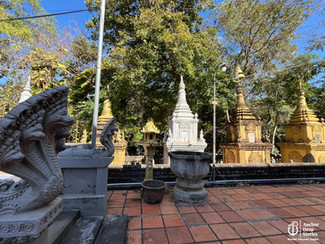











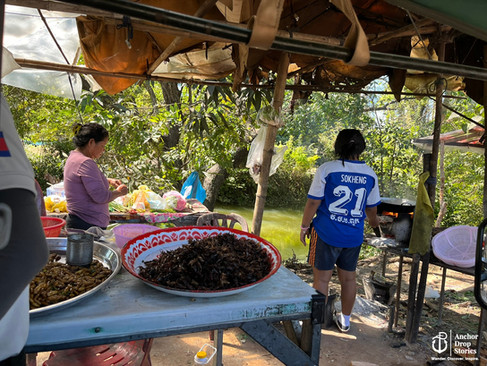













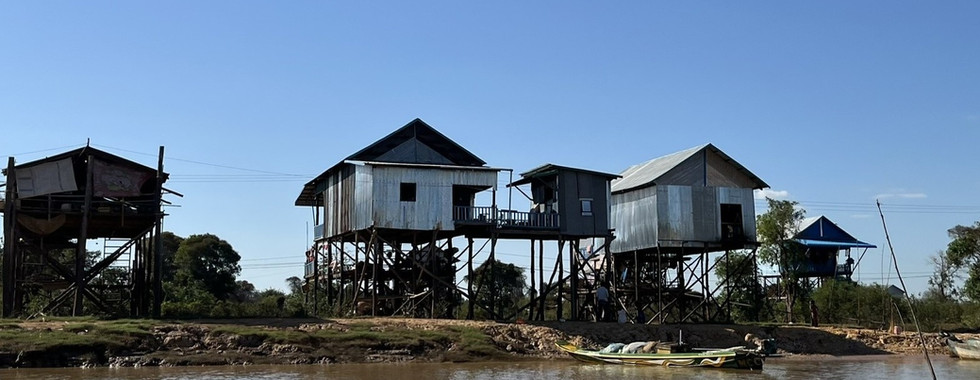
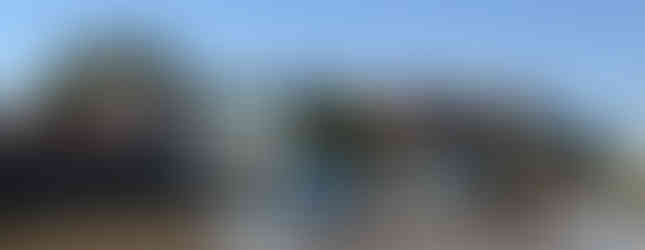








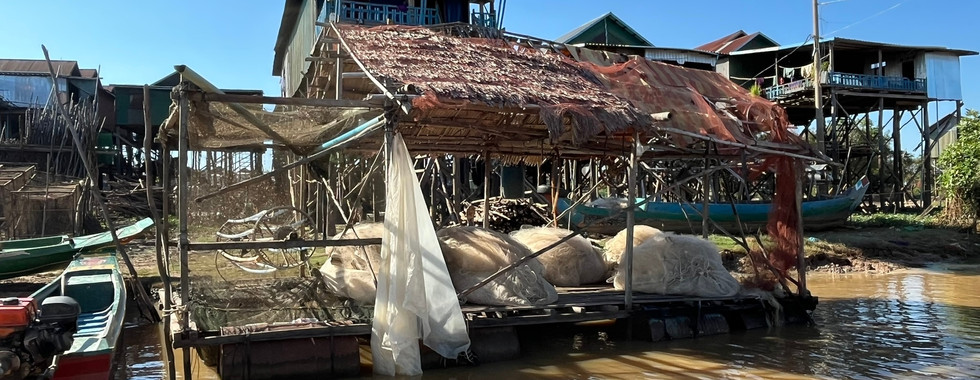







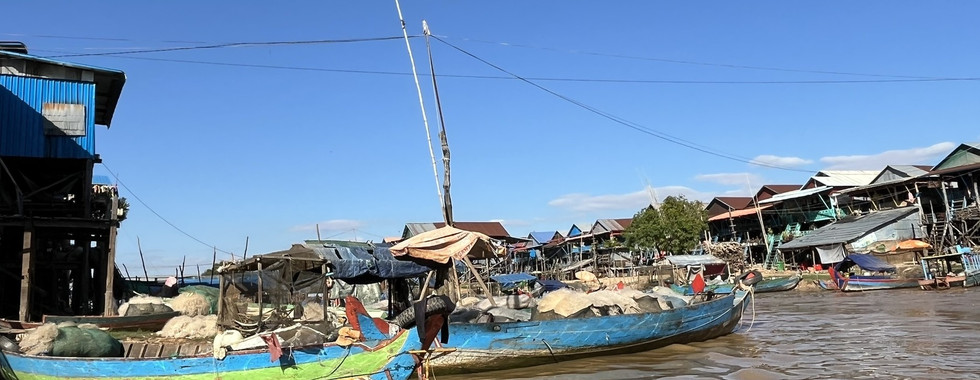







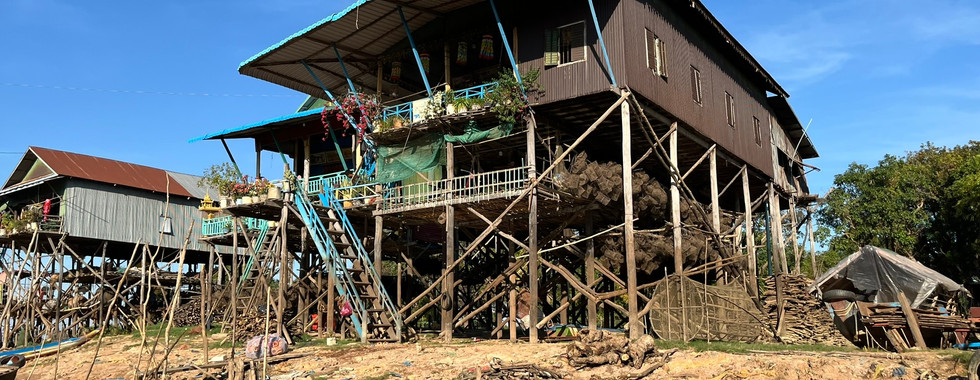















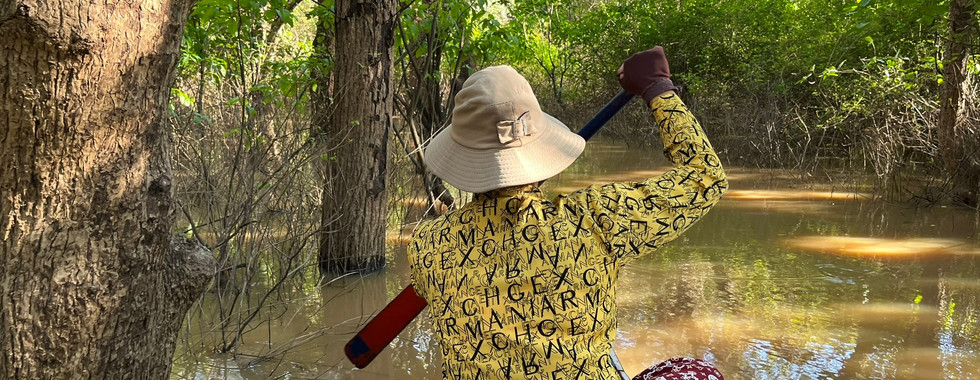


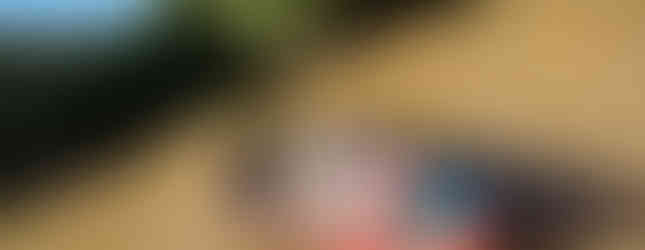











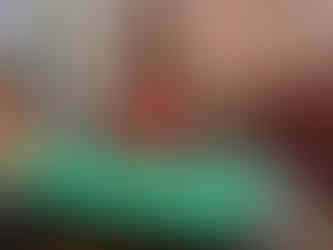











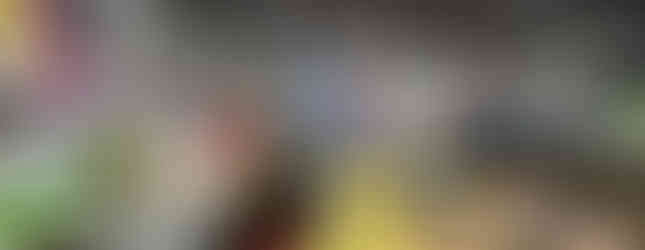


















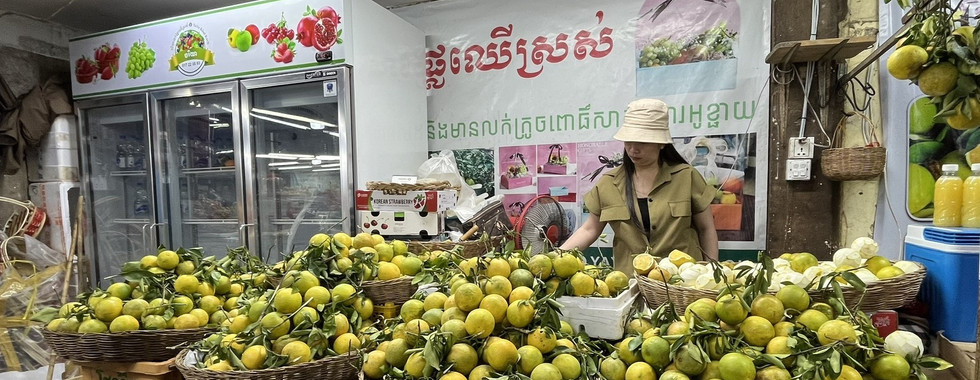







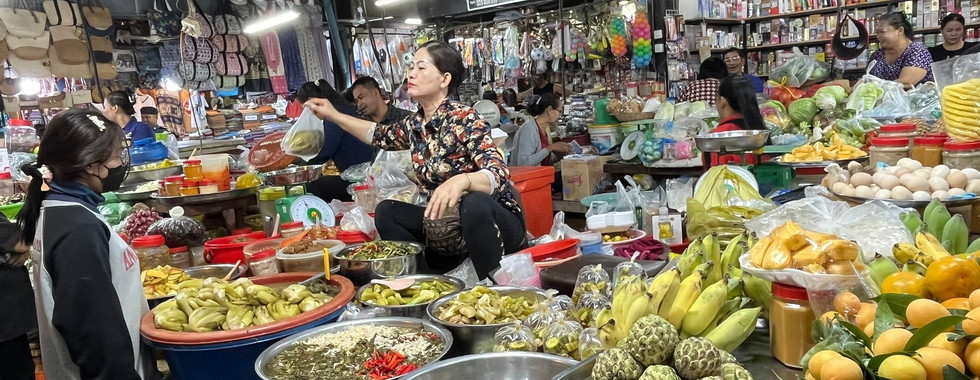



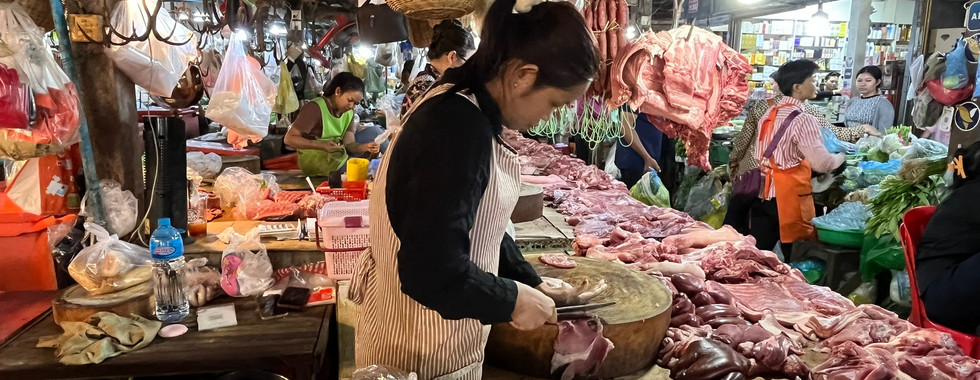

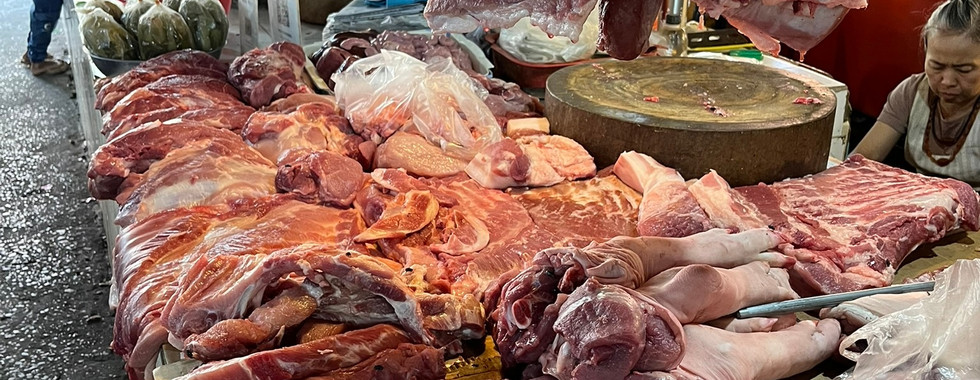

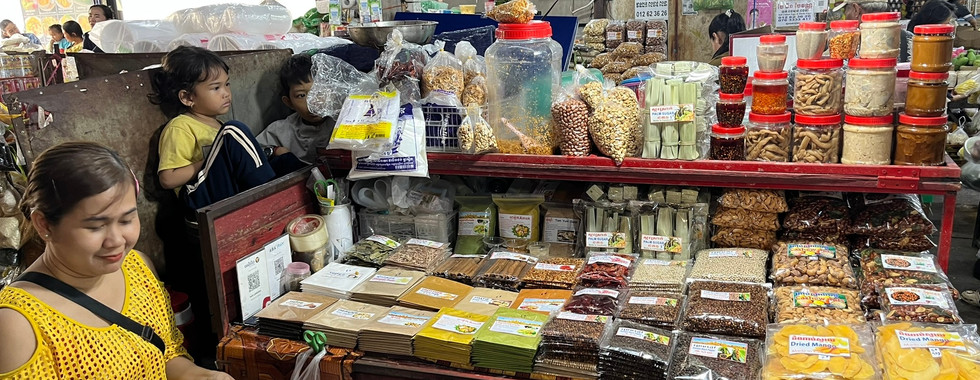


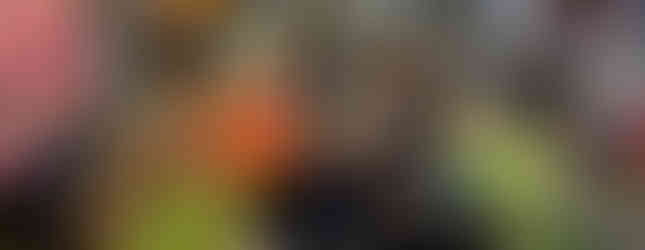









You look so happy! What a lovely time. We miss you and are so happy for you and Eddie.
The bugs were yummy. If we ever get lost in the jungle we know what to eat.😀
Cristina what a way to start off the day - first email I hungerly devoured! I almost missed the ability to go through the row of pictures, but had to go again. So, so much in here from Angor Wat to the markets to eating bugs (!) to shopping at markets. For me the temples, the night market and the craft stores and the boat rides....well basically everything (except for the raw meat and eating almost born chicks....) looked incredible!
And all with your usual smooth style of writing. Thank you and yes, I want more?😛